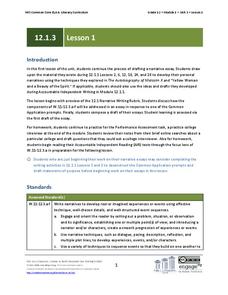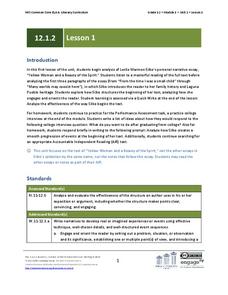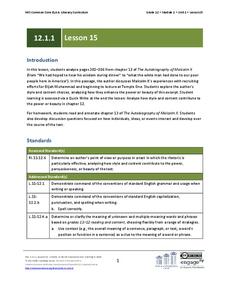EngageNY
Grade 12 ELA Module 1, Unit 3, Lesson 1
In this first activity of the unit, class members continue to work on their draft of a narrative essay response to a prompt found on the college Common Application.
EngageNY
Grade 12 ELA Module 1, Unit 2, Lesson 1
As part of a study of narrative writing, class members analyze how Leslie Marmon Silko structures the beginning and orients and engages readers in her narrative, "Yellow Woman and a Beauty of the Spirit."
EngageNY
Grade 12 ELA Module 1, Unit 2, Lesson 5
As class members conclude their reading of Leslie Marmon Silko's "Yellow Woman and a Beauty of the Spirit," they consider how the story of Kochininako, Yellow Woman, not only provides a satisfying ending to the narrative but also...
EngageNY
Grade 12 ELA Module 1, Unit 2, Lesson 4
The fourth instructional activity in this narrative writing unit focuses on how Leslie Marmon Silko uses telling details and sensory language in her "Yellow Woman and a Beauty of the Spirit" to bring alive the people of Laguna Pueblo and...
EngageNY
Grade 12 ELA Module 1, Unit 2, Lesson 3
How does an author sequence events in a narrative so that the events build on one another and create a tone of mystery, growth, or resolution? As part of a study of narrative writing, class members work in pairs to examine the techniques...
EngageNY
Grade 12 ELA Module 1, Unit 2, Lesson 2
As part of their reading of Leslie Marmon Silko's "Yellow Woman and a Beauty of the Spirit," class members analyze how the author develops her narrative through dialogue, description, and multiple plot lines.
EngageNY
Grade 12 ELA Module 1: Unit 1, Lesson 28
After discussing Haley's techniques in his conclusion of The Autobiography of Malcolm X, class time is devoted to drafting, sharing, and getting feedback on writers' college essays.
EngageNY
Grade 12 ELA Module 1: Unit 1, Lesson 25
Class members return to the discussion of The Autobiography of Malcolm X using the questions they developed and their annotated notes of the events in chapter 17.
EngageNY
Grade 12 ELA Module 1: Unit 1, Lesson 19
Class members return to a discussion of The Autobiography of Malcolm X, discussing how Haley foreshadows the growing distrust and downturns in the influence of the Nation of Islam.
EngageNY
Grade 12 ELA Module 1: Unit 1, Lesson 18
Class members take a break from discussing The Autobiography of Malcolm X to focus on their personal narrative essays. Before working on their drafts, they review what they have learned from their study of Haley's narrative about...
EngageNY
Grade 12 ELA Module 1: Unit 1, Lesson 17
Integration versus separation. Readers of chapter 14 of The Autobiography of Malcolm X examine Malcolm X's views on other Civil Rights leaders and their integration ideas. Class members also return to the narrative essay strand of the...
EngageNY
Grade 12 ELA Module 1: Unit 1, Lesson 16
Class members discuss Chapter 13 of The Autobiography of Malcolm X and use evidence from their character development worksheet to support an analysis of how Malcolm X and attitudes toward him and his teachings are changing.
EngageNY
Grade 12 ELA Module 1: Unit 1, Lesson 15
Chapter 12 of The Autobiography of Malcolm X discusses Haley's narrative techniques, mainly how he uses point of view and foreshadowing to build interest and suspense. Class members read and annotate chapter 13 of the text as homework...
EngageNY
Grade 12 ELA Module 1: Unit 1, Lesson 12
Writers use class time to develop the draft of their personal narratives, drawing on techniques Haley uses in The Autobiography of Malcolm X.
EngageNY
Grade 12 ELA Module 1: Unit 1, Lesson 11
Chapter 10 of Malcolm X's Autobiography introduces readers to Elijah Muhammad's teachings. Discussion questions focusing on syntax and diction draw attention to how Malcolm X's perspective on Mr. Muhammad changes.
EngageNY
Grade 12 ELA Module 1: Unit 1, Lesson 10
Readers examine the rhetorical devices Haley uses in chapter 8 of The Autobiography of Malcolm X, paying particular attention to the diction and syntax and how these choices reveal changes in Malcolm X's point of view.
EngageNY
Grade 12 ELA Module 1: Unit 1, Lesson 9
As they read and discuss Chapter 7 of The Autobiography of Malcolm X, class members continue to use the Tracking Tool worksheet to record evidence on how the central ideas are being developed.
EngageNY
Grade 12 ELA Module 1: Unit 1, Lesson 8
Readers use the provided worksheet to analyze the narrative techniques Haley uses in chapter 6 of The Autobiography of Malcolm X to continue the development of the central ideas of racial identity and systemic oppression.
EngageNY
Grade 12 ELA Module 1: Unit 1, Lesson 7
Readers of The Autobiography of Malcolm X examine how Haley's word choice and point of view in chapter 5 reveal Malcolm X's attitude toward his behavior as he travels from Lansing to Harlem.
EngageNY
Grade 12 ELA Module 1: Unit 1, Lesson 5
Zoot suits, the Lindy hop, and conks. Readers carefully examine the rhetoric of chapter 4 of The Autobiography of Malcolm X, analyze the effectiveness of using slang to develop a narrative, and consider how they might incorporate Haley's...
EngageNY
Grade 12 ELA Module 1: Unit 1, Lesson 4
Chapter 3 of The Autobiography of Malcolm X discusses how central ideas are developed in a narrative. Readers use the provided annotated bookmark to record evidence of ideas such as racial identity, integration/separation, and systemic...
EngageNY
Grade 12 ELA Module 1: Unit 1, Lesson 3
Using questions they developed, class groups discuss Chapter 2 of Malcolm X's autobiography, focusing on the individuals and events Malcolm X feels contributed to his character development.
EngageNY
Grade 12 ELA Module 1: Unit 1, Lesson 2
After discussing the narrative structure, intended audience, and purpose of Chapter 1 of The Autobiography of Malcolm X, class members draft their statement of purpose for a Common College Application prompt that distinguishes them from...
EngageNY
Grade 12 ELA Module 1: Unit 1, Lesson 1
Here's a fresh approach to the dreaded personal narrative required by most college applications. The Autobiography of Malcolm X is the anchor text for a unit that, through modeling and guided practice exercises, encourages the...

























